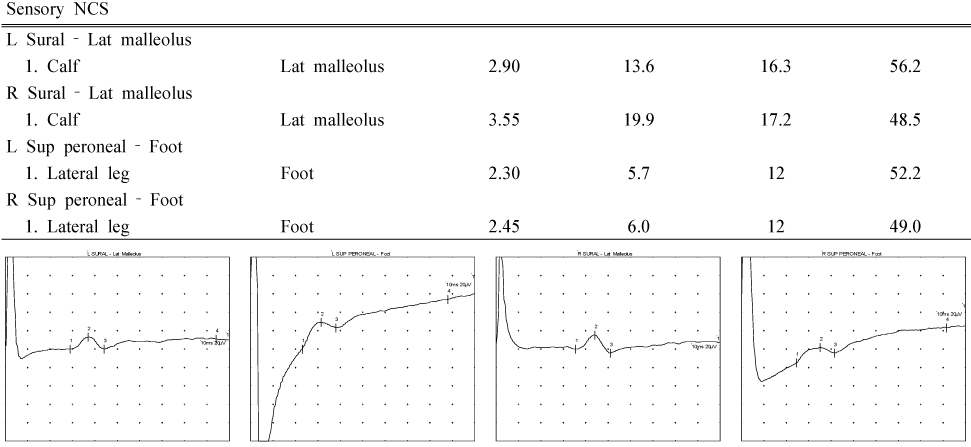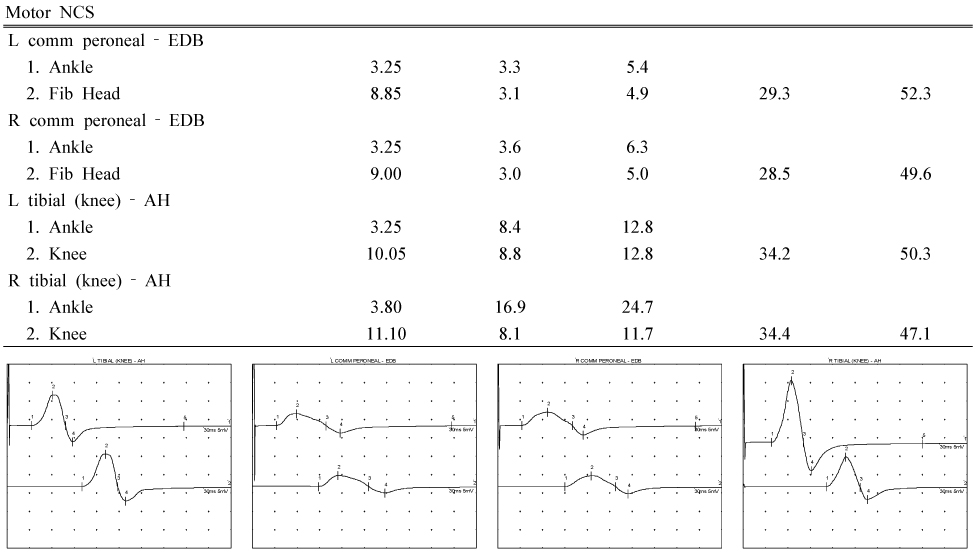Korean J Obstet Gynecol.
2010 Oct;53(10):940-945. 10.5468/kjog.2010.53.10.940.
A case of primary restless leg syndrome aggravated by pregnancy
- Affiliations
-
- 1Department of Obstetrics and Gynecology, Soonchunhyang University Cheonan Hospital, Soonchunhyang University College of Medicine, Cheonan, Korea. drsook@schmc.ac.kr
- 2Department of Neurology, Soonchunhyang University Cheonan Hospital, Soonchunhyang University College of Medicine, Cheonan, Korea.
- KMID: 1453760
- DOI: http://doi.org/10.5468/kjog.2010.53.10.940
Abstract
- Restless leg syndrome (RLS) is characterized by intense restlessness and unpleasant creeping sensations deep inside the lower legs, occurring during periods of rest, evening and night. These symptoms can be improved by movement. There are two different phenotypes of RLS. One early-onset form starts before 36 years old. It has mostly a familial history, severe symptoms, and highly genetically determined. And it is a highly dependent to iron level of the brain. The other delayed-onset form starts after 36 years old, mostly secondary, without familial history, with a rapid evolution in two or three years. And it is associated with frequent low ferritin level of serum. Pathophysiology of RLS remains incompletely understood. However, advanced studies suggest that RLS may be generated by dopamine dysfunction locally within the central nervous system. Dopaminergic agonists are the treatment of choice, if the symptoms are severe. And iron therapy improves RLS symptoms in iron deprived patients. Early detection during pregnancy is needed because RLS gives an important impact on sleep efficiency and quality of life. Recently we have experienced a case of primary RLS patient diagnosed at 24+3 weeks, treated by dopaminergic agonist ropinirole and iron. We describe this case with a brief review of the literature.
Keyword
MeSH Terms
Figure
Reference
-
1. Pereira JC Jr, Pradella-Hallinan M, de Lins Pessoa H. Imbalance between thyroid hormones and the dopaminergic system might be central to the pathophysiology of restless legs syndrome: a hypothesis. Clinics (Sao Paulo). 2010. 65:548–554.2. Kranick SM, Mowry EM, Colcher A, Horn S, Golbe LI. Movement disorders and pregnancy: a review of the literature. Mov Disord. 2010. 25:665–671.3. Ekbom K, Ulfberg J. Restless legs syndrome. J Intern Med. 2009. 266:419–431.4. Golbe LI. Pregnancy and movement disorders. Neurol Clin. 1994. 12:497–508.5. Ham BJ. Diagnosis and treatment of restless leg syndrome and periodic limb movement of sleep. Sleep Med Psychophysiol. 2003. 10:26–31.6. Facco FL, Kramer J, Ho KH, Zee PC, Grobman WA. Sleep disturbances in pregnancy. Obstet Gynecol. 2010. 115:77–83.7. Bosco D, Plastino M, Fava A, Ettore M, Bosco F, Ermio C, et al. Role of the Oral Glucose Tolerance Test (OGTT) in the idiopathic restless legs syndrome. J Neurol Sci. 2009. 287:60–63.8. Gabaldon Torres L, Salas Felipe J, Fernandez Dominguez J, Vivancos Matellanos F, Izal E, Arpa Gutierrez F. Restless legs syndrome. Features and impact on sleep. Neurologia. 2009. 24:230–234.9. Manconi M, Govoni V, De Vito A, Economou NT, Cesnik E, Casetta I, et al. Restless legs syndrome and pregnancy. Neurology. 2004. 63:1065–1069.10. Kim DS, Shin HB, Ahn YM. A case of restless legs syndrome in a child presenting with growing pains. Korean J Pediatr. 2008. 51:1222–1227.11. Woo J, Chang S. Restless leg syndrome and psychotropic drug. Sleep Med Psychophysiol. 2010. 17:5–10.12. Djokanovic N, Garcia-Bournissen F, Koren G. Medications for restless legs syndrome in pregnancy. J Obstet Gynaecol Can. 2008. 30:505–507.13. Hening W, Allen RP, Tenzer P, Winkelman JW. Restless legs syndrome: demographics, presentation, and differential diagnosis. Geriatrics. 2007. 62:26–29.14. Patrick LR. Restless legs syndrome: pathophysiology and the role of iron and folate. Altern Med Rev. 2007. 12:101–112.
- Full Text Links
- Actions
-
Cited
- CITED
-
- Close
- Share
- Similar articles
-
- A Case of Restless Leg Syndrome Induced by Mirtazapine in a Patient with Major Depressive Disorder
- Severe Restless Legs Syndrome in a Pregnant Woman Leading to Induced Premature Birth
- Periodic Limb Movement and Restless legs Syndrome in Neurological Disorders
- A Case of Restless Legs Syndrome in Patient with Neurogenic Sciatic Nerve Tumor
- Effect of a Complex Leg Exercise Program for Hemodialysis Patients with Restless Legs Syndrome



